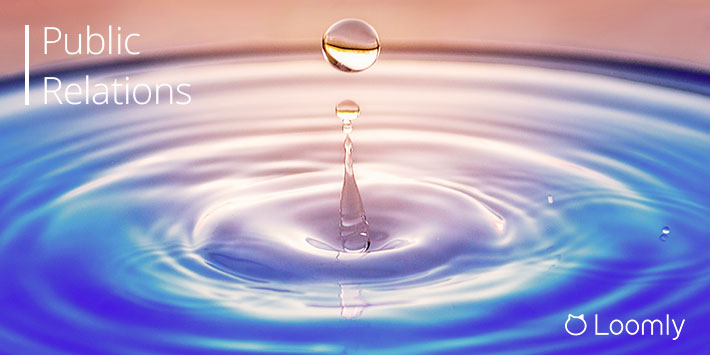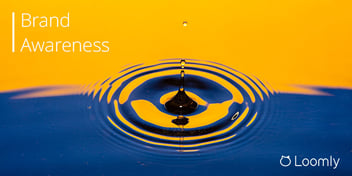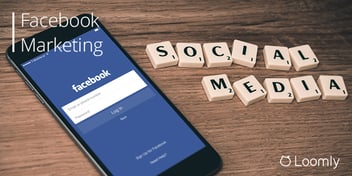Public relations is not a new concept – it defines how an organization communicates with its audience and builds its reputation.
But how brands use PR has changed significantly.
For starters, new digital PR channels like blogs, podcasts, and social media overshadow the traditional PR channels of radio, newspaper, and television.
In fact, social media and public relations work together seamlessly. Not only do brands use social media as a PR channel, but they also use it to connect with journalists and then share the media articles that mention their name.
If you want to learn how to boost the reputation of your brand, then read on.
Inside, you’ll discover:
- What public relations is
- The difference between public relations and marketing
- Why public relations matter for your brand
- The risks of public relations
- Examples of successful public relations campaigns
- How to implement a winning public relations strategy
Let’s start!

Manage all your social media accounts in one place.
Craft, schedule, & auto-post content to all your social channels, then track analytics and manage interactions from a single, easy-to-use dashboard.
What is Public Relations?
Public relations (also referred to as PR) is the strategic management function that helps your organization manage its reputation and build a positive connection with the public.
PR functions by leveraging media platforms, initiating dialogues with the audience, and storytelling. In short, it aims to ensure that the public perception of your organization is aligned with your goals.
The Difference Between Public Relations and Marketing
PR and marketing are complementary to each other as they are part of the same family of communications. They often deploy the same tactics but with starkly different goals.
The goal of marketing, in most cases, is to promote and drive sales. But the focus of PR is reputation and brand building, as well as increasing sales indirectly.
They also use the same channels differently. For example, a social media platform is not only used as a distribution channel for PR but also as a medium to establish positive relationships with journalists and customers.
Re-sharing media commentary on your brand builds authenticity and credibility. However, for marketing, a social media platform acts solely as the distribution channel.
Moreover, public relations helps the company retrieve its reputation in case of a PR crisis, whereas marketing strategy does not take backlash into account.

Why Public Relations Matter for Your Brand (More Than Ever)
As digital media continues to disrupt traditional advertising, PR has become necessary for brands. PR helps you:
- Earn credibility: A recent study shows how public trust in media platforms is declining by the year and is being replaced by their faith in journalism. Getting earned media through PR will build your brand’s credibility and get the public to trust you.
- Increase brand awareness: PR is one of the most cost-effective ways to build your brand awareness and authority at scale. A strong brand gives you a competitive edge along with increased customer loyalty.
- Boost SEO: PR helps you get backlinks from reputed and trusted sources, giving you the leverage of their domain authority. These backlinks, in turn, enable you to generate more traffic, conversions, and higher rankings. The same links will introduce your brand to new readers who could be your potential customers.
- Attract investors: Buzz in media about your product or service is sure to attract potential investors.
- Employ best talent: Positioning yourself as a thought leader in your industry will attract the best talent to your company, helping you recruit the right people to grow further.
The Risks of Public Relations
“It takes 20 years to build a reputation and five minutes to ruin it. If you think about that, you’ll do things differently.” — Warren Buffet.
Your business reputation can either be built or harmed by PR, as it exposes your brand to:
- Lack of control: PR relies heavily on earned media and user-generated content (UGC). But companies don’t have direct control over the type of media coverage.
- Miscommunication: The key messages of PR campaigns are crafted strategically. But the risk of miscommunication with the audience still exists. The message can be framed without context or recrafted by the media leading to confusion.
- PR crisis: The lack of direct control over content leaves your brand at potential risk of a PR crisis, which can tarnish the brand image entirely if not handled immediately.
Having an effective PR strategy can help your brand recover from a potential crisis and foster a positive relationship with your audience.
Examples of Successful Public Relations Campaigns
Let’s take a look at some successful PR campaigns:
Coca-Cola – ‘Share a Coke’
Coca-Cola’s ‘Share a Coke’ campaign is one of the most successful PR campaigns of all time.
What they did: In 2011, Coca-Cola replaced its iconic logo with 150 popular names in Australia. The label read “Share a coke with…” followed by one of the 150 names.
They encouraged people to share a tweet using the hashtag #ShareaCoke with their experience. People were excited to find a bottle with their first names or a name with a personal meaning.
The campaign took off, and the company’s Facebook page grew by 39%.
Why it worked: The campaign worked primarily on user-generated content (UGC). The factors of its success are:
- Personal connection with the audience
- A clear CTA of “Share a Coke”
- Timely updates
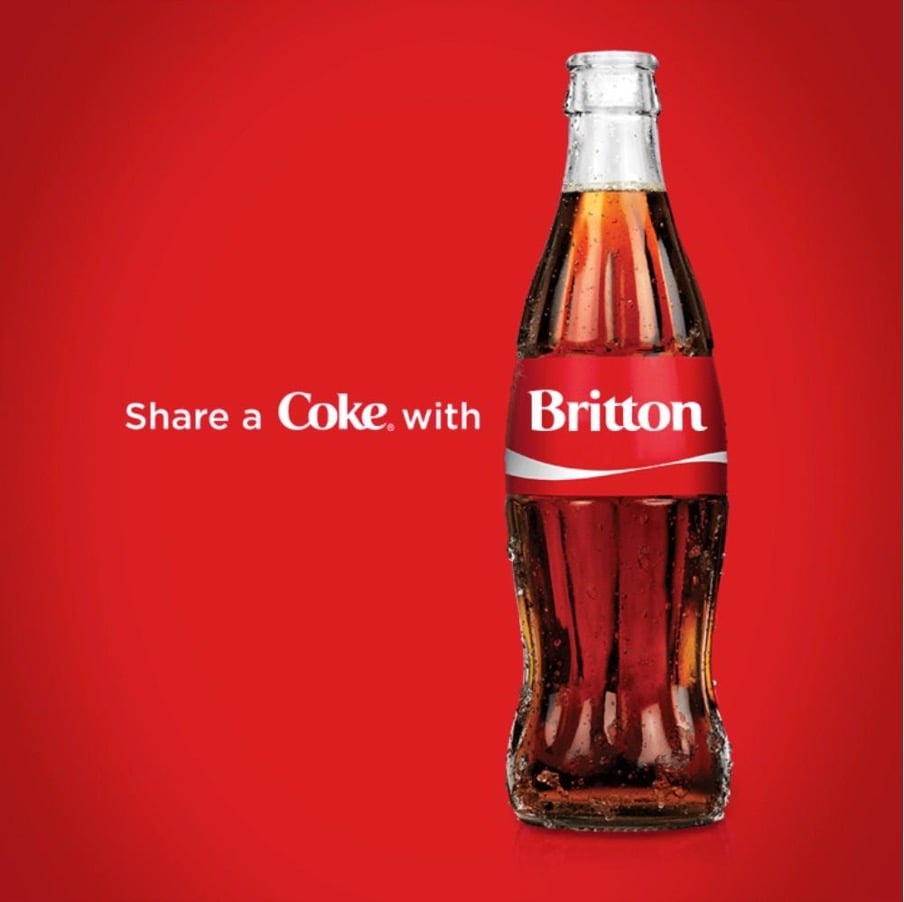
Proctor & Gamble – #DistanceDance
Proctor & Gamble’s #DistanceDance campaign is one of the best examples of a PR campaign taking off on social media.
What they did: Proctor & Gamble (P&G) collaborated with Charli D’Amelio, the TikTok star with the highest number of followers on the platform, to encourage people to stay home amidst the pandemic in March 2020.
P&G pledged to donate to Feeding America and Matthew25 for the first 3 million videos. The result was millions of videos, resulting in billions of views. The hashtag has garnered 16 billion views alone.
Why it worked: P&G leveraged influencer marketing strategically. The success can be credited to the combined use of a popular social media platform (of their target audience) and an entertainment form (dance).
DiGiorno – #DeliveryDigiorno
DiGiorno turned to Twitter to capture customer attention.
What they did: In October 2019, during National Pizza Month, DiGiorno launched their #DeliverDiGiorno campaign. Delivering 1,100 free pizza in a month, they brought their slogan, “It’s not delivery, it’s DiGiorno,” to life.
They aimed to increase brand awareness and engagement. To achieve their goal, they used paid promotion on Twitter (promoted tweets and trends) to utilize the full potential of the opportunity and reach more people.
The campaign was a massive success with 55.3 million impressions, 1.75 million tweets, and 78% positive sentiment.
We're getting in the delivery game during National Pizza Month!
Tweet #DeliverDiGiorno + your city and you could have DiGiorno delivered! pic.twitter.com/BCyaNJfpaZ
— DiGiorno (@DiGiorno) September 23, 2019
Why it worked: DiGiorno understood the interest of their audience and centered their campaign around a topical subject (National Pizza Month). A mix of promoted tweets and organic content boosted their reach, and offering a reward (free pizza) for participation increased the overall engagement of the audience.
How to Implement a Winning Public Relations Strategy
Follow this five-step framework to implement a winning public relations strategy:
- Define your goals and objectives
- Identify your target audience
- Craft your key message
- Choose your PR tactics
- Measure your progress
1. Define your goals and objectives
Defining your goals and setting objectives will help you determine your target audience accurately and create relevant content for them.
It will also help you decide on the tools and tactics you can use to meet your objectives effectively. Your goal may include:
- Creating brand awareness
- Building goodwill and reputation
- Mitigating PR crisis
- Launching a new product/service
Although your goals can be qualitative, your objectives have to be quantitative. For example, if your goal is to increase customer engagement, set a target increase in website traffic and social media followers in a particular time frame (15% increase in 3 months).
Your objective should be SMART:
- Specific – What exactly do you want to achieve?
- Measurable – How will you measure it?
- Achievable – Is it attainable given the constraints of budget and time?
- Relevant – Is your goal relevant to the brand and its plans?
- Time-based – Within what time frame are you going to accomplish it?
Without meeting the SMART criteria, it’s hard to build and track the success of a PR campaign. A PR goal is always hard to measure, but attaching it to clear, measurable objectives will help track the campaign’s overall success.
2. Identify your target audience
Public relations is primarily about building relationships with your audience. But the identification of your audience comes before relationship building.
The target audience varies based on your goals. Some examples include:
- Existing and potential customers
- Stakeholders
- Employees
- Vendors
- Media
Your target audience will hugely impact the type of content you create and the PR tactics you use to reach them.
After determining your target audience, research their interests, habits, what they care about, and the type of media they like to consume. Tailor your content according to their likings.
A content strategy tailored according to your audience’s interests will not seem ‘interrupting’ to them. And you’re more likely to see a positive response.
Taking time to craft the buyer persona in detail will reap the rewards in the later stages.
3. Craft your key message
A key message is the master narrative of your PR campaign. It is the gist of what you want to convey to the audience.
The features of a perfect key message are:
- Succinct: Your key message should contain a maximum of 3 statements, or when spoken, it should be under 30 seconds. At the same time, it should be simple and easily understandable, free of any jargon.
- Convincing: It should be believable and credible, written meaningfully to drive action.
- Exclusive: It should be able to distinguish itself from competitors and highlight your unique value proposition.
- Relevant: It should align with your bigger goals and your brand image.
How to develop a winning key message
Your key message should ideally follow the structure of:
“[central message] [supporting statement] [proof point].”
Take the real-life example of 3M – they have skillfully highlighted the proof point and supporting statement along with their key message.
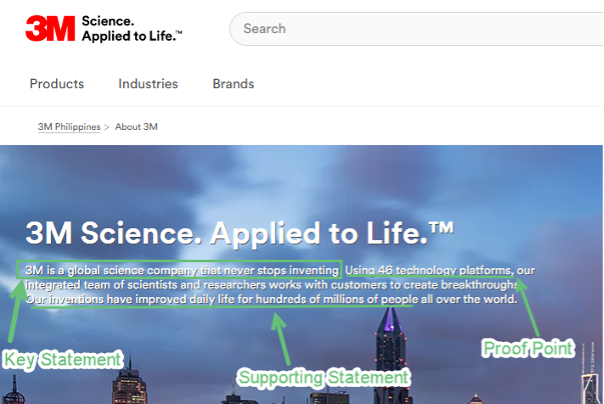
- 3M is a global science company [key statement]
- Using 46 technology platforms [proof point]
- Our integrated team of scientists and researchers works with customers [proof point]
- Our inventions have improved daily life for hundreds of millions of people [supporting statement]
You can use the following method to deliver a key message that drives attention and action:
- Revisit your campaign and company goals. Your message should not only align with them but should also be able to communicate them more effectively.
- Speak how your target audience speaks, and understand the SEO implications of the words and phrases used.
- Do a competitive analysis to ensure your message is distinct and not too similar to your competitors.
- Conduct a test with a small internal and external audience.
- Review your message timely to ensure it is not stagnant and evolves as your brand and audience grow.
4. Choose your PR tactics
Tactics are the various methods you use to reach your audience to achieve the campaign goals.
You can divide your tactics into two parts:
- Content creation
- Content distribution
Content creation
The type of content you create depends on your goal and target audience. For example, if your goal is to position the brand as a thought leader and increase brand awareness, your content should be informative and educational.
Perform in-depth research of keywords to understand your audience and their search intent better.
Content distribution
You can reach your audience through various channels, but which one is the most effective?
The PESO model answers this question. You can broadly divide the media into four types:
- Paid
- Earned
- Shared
- Owned
Paid Media
As the name suggests, paid media is when you pay for your content to be visible. It includes:
- Social media ads
- Influencer marketing
- Search engine marketing (SEM)
- Press Release
- Guest posts
Earned Media
Earned media is the content about your brand created by external sources. The brand has no direct control over this channel, which can also be the source of a PR crisis if not handled well. It includes:
- Appearance in industry news
- Interviews
- Press conferences
- Rankings on search engines
Shared Media
Shared media is the content generated on third-party platforms. It’s one of the most important factors since it builds authenticity and trust, and includes:
- Social media posts
- User-generated content (UGC)
- Customer reviews
Owned Media
Owned media is the channels your business can directly control. It forms the base of most PR campaigns and includes:
- Blog posts
- Email newsletters
- White papers
- Website copy
- Webinars
A combination of all these four channels works the best. But you can start with the place where your target audience spends the most time. For example:
- Goal: Stimulating demand
- Audience: Existing and potential customers
- Content: A mix of informative and promotional content
- Distribution: Social media platforms, press releases, interviews, etc.
5. Measure your progress
As you’ve already set the KPI while setting your goals and objectives, tracking your progress shouldn’t be complex – it just has to be timely.
Tracking your progress allows you to review and modify your original plan. Here are some metrics you can monitor:
- Social media engagement, growth, and reach
- Website traffic and rankings
- Email click-through and open rate
- Conversions
- Backlinks to your website
- Domain authority score
- Brand mentions
- Media outreach
Loomly Tip: You can use the Advanced Analytics feature to track everything in one place and help you identify room for growth.
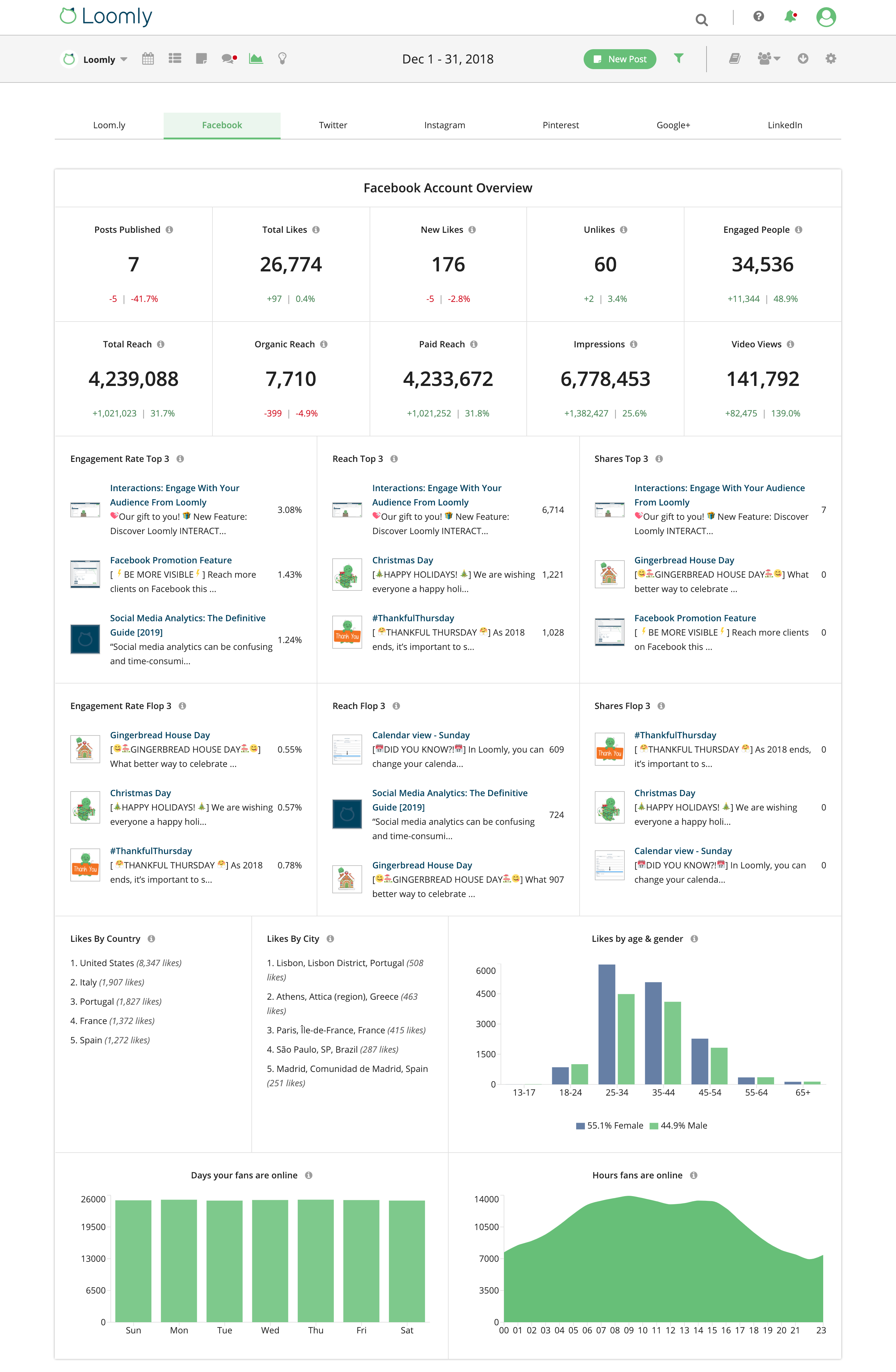
Public Relations in a Nutshell
Public relations helps you reach your target audience and deliver your message strategically to enhance your reputation. It can help you:
- Increase brand awareness
- Earn credibility
- Boost SEO
- Employ the best talent
- Attract investors
Follow this five-step guide to implement a winning public relations strategy for your brand:
- Define your goals and objectives
- Identify your target audience
- Craft your key message
- Choose your PR tactics
- Measure your progress
